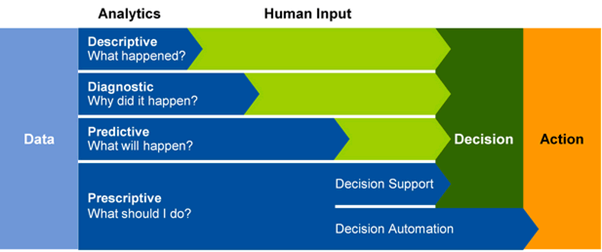The technological research and consulting firm Gartner defines four common types of analytical technique that organizations commonly use:
Descriptive analytics, which answers the question “What is happening in my business?”. The data to answer this question is typically answered through the creation of a data warehouse in which historical data is persisted in relational tables for multidimensional modeling and reporting.
Diagnostic analytics, which deals with answering the question “Why is it happening?”. This may involve exploring information that already exists in a data warehouse, but typically involves a wider search of your data estate to find more data to support this type of analysis.
Predictive analytics, which enables you to answer the question “What is likely to happen in the future based on previous trends and patterns?”
Prescriptive analytics, which enables autonomous decision making based on real-time or near real-time analysis of data, using predictive analytics.

Azure Synapse Analytics provides a cloud platform for all of these analytical workloads through support for multiple data storage, processing, and analysis technologies in a single, integrated solution. The integrated design of Azure Synapse Analytics enables organizations to leverage investments and skills in multiple commonly used data technologies, including SQL, Apache Spark, and others; while providing a centrally managed service and a single, consistent user interface.
How Azure Synapse Analytics works
you can create a Synapse Analytics workspace in an Azure subscription interactively by using the Azure portal, or you can automate deployment by using Azure PowerShell, the Azure command-line interface (CLI), or with an Azure Resource Manager or Bicep template.
After creating a Synapse Analytics workspace, you can manage the services in it and perform data analytics tasks with them by using Synapse Studio; a web-based portal for Azure Synapse Analytics.
Working with files in a data lake
One of the core resources in a Synapse Analytics workspace is a data lake, in which data files can be stored and processed at scale. A workspace typically has a default data lake, which is implemented as a linked service to an Azure Data Lake Storage Gen2 container. You can add linked services for multiple data lakes that are based on different storage platforms as required.
Ingesting and transforming data with pipelines
In most enterprise data analytics solutions, data is extracted from multiple operational sources and transferred to a central data lake or data warehouse for analysis. Azure Synapse Analytics includes built-in support for creating, running, and managing pipelines that orchestrate the activities necessary to retrieve data from a range of sources, transform the data as required, and load the resulting transformed data into an analytical store.
Azure Synapse Analytics supports SQL-based data querying and manipulation through two kinds of SQL pool that are based on the SQL Server relational database engine:
- A built-in serverless pool that is optimized for using relational SQL semantics to query file-based data in a data lake.
- Custom dedicated SQL pools that host relational data warehouses.
Exploring data with Data Explorer
Azure Synapse Data Explorer is a data processing engine in Azure Synapse Analytics that is based on the Azure Data Explorer service. Data Explorer uses an intuitive query syntax named Kusto Query Language (KQL) to enable high performance, low-latency analysis of batch and streaming data.
Azure Synapse Analytics can be integrated with other Azure data services for end-to-end analytics solutions. Integrated solutions include:
- Azure Synapse Link enables near-realtime synchronization between operational data in Azure Cosmos DB, Azure SQL Database, SQL Server, and Microsoft Power Platform Dataverse and analytical data storage that can be queried in Azure Synapse Analytics.
- Microsoft Power BI integration enables data analysts to integrate a Power BI workspace into a Synapse workspace, and perform interactive data visualization in Azure Synapse Studio.
- Microsoft Purview integration enables organizations to catalog data assets in Azure Synapse Analytics, and makes it easier for data engineers to find data assets and track data lineage when implementing data pipelines that ingest data into Azure Synapse Analytics.
- Azure Machine Learning integration enables data analysts and data scientists to integrate predictive model training and consumption into analytical solutions.